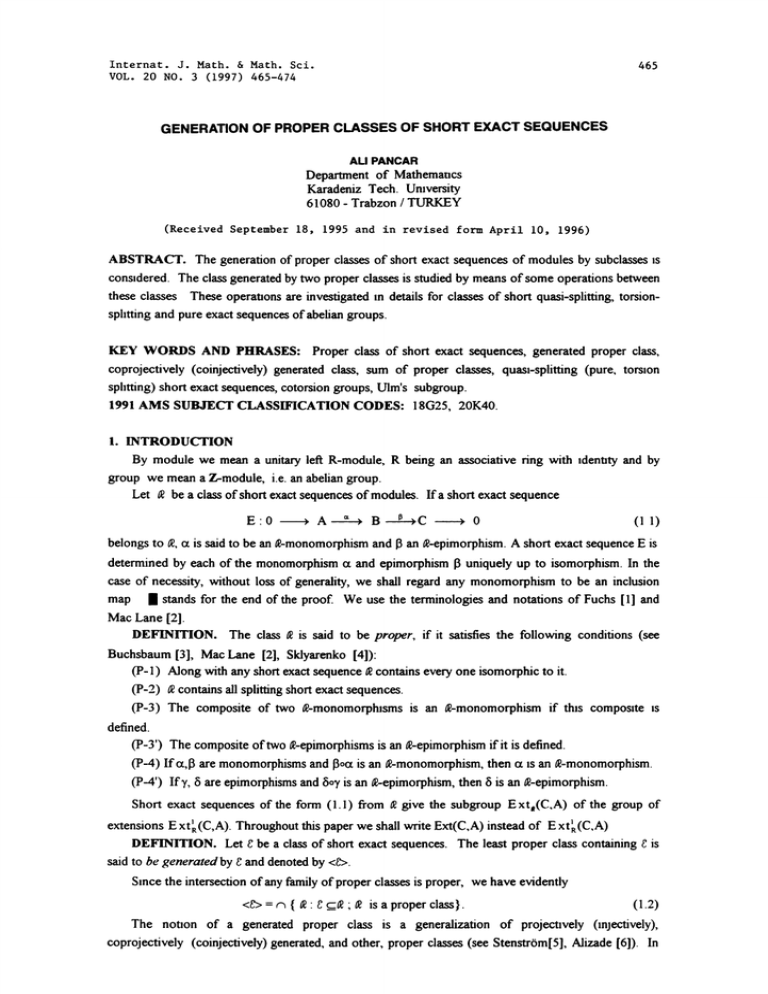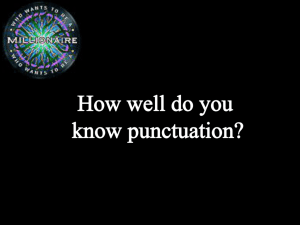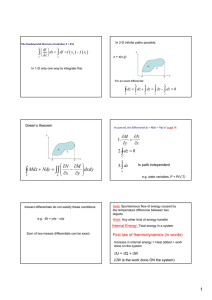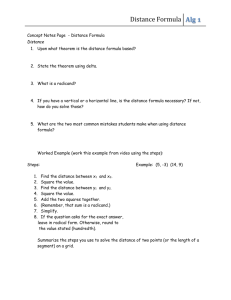Document 10468910
advertisement

Internat. J. Math. & Math. Sci.
VOL. 20 NO. 3 (1997) 465-474
465
GENERATION OF PROPER CLASSES OF SHORT EXACT SEQUENCES
ALl PANCAR
Department of Mathemaucs
Karadeniz Tech. Umversity
61080 Trabzon TURKEY
(Received September 18, 1995 and in revised form April I0, 1996)
ABSTRACT. The generation of proper classes of short exact sequences of modules by subclasses s
considered. The class generated by two proper classes is studied by means of some operations between
these classes These operauons are investigated m details for classes of short quasi-splitting, torsionsphtting and pure exact sequences of abelian groups.
KEY WORDS AND PHRASES: Proper class of short exact sequences, generated proper class,
coprojectively (coinjectively) generated class, sum of proper classes, quam-splitting (pure, torsion
sphtting) short exact sequences, cotorsion groups, Ulm’s subgroup.
1991 AMS SUBJECT CLASSIFICATION CODES: 18G25, 20K40.
1. INTRODUCrlON
By module we mean a unitary left Romodule, R being an associative ring with tdentty and by
group we mean a Z-module, i.e. an abelian group.
Let be a class of short exact sequences of modules. If a short exact sequence
E:0
A
B
>C
0
(1 1)
belongs to/, ot is said to be an R-monomorphism and 13 an R-epimorphism. A short exact sequence E is
determined by each of the monomorphism t and epimorphism 15 uniquely up to isomorphism. In the
case of necessity, without loss of generality, we shall regard any monomorphism to be an inclusion
map B stands for the end of the proof. We use the terminologies and notations of Fuchs [1] and
Mac Lane [2].
DEFINITION. The class is said to be proper, if it satisfies the following conditions (see
Buchsbaum [3], Mac Lane [2], Sldyarenko [4]):
(P-1) Along with any short exact sequence contains every one isomorphic to it.
(Po2) contains all splitting short exact sequences.
(P-3) The composite of two -monomorphsms is an -monomorphism if ths compomte ss
defined.
-3’) The composite of two -epimorphisms is an -epimorphism if it is defined.
(P-4) If c, are monomorphisms and Io is an -monomorphism, then c s an -monomorphism.
(P-4’) If/, are epimorphisms and fio/is an -epimorphism, then fi is an -epimorphism.
Short exact sequences of the form (1.1) from give the subgroup E xt(C,A) of the group of
extensions E xt(C,A). Throuout this paper we shall write Ext(C,A) instead of E xt(C,A)
DEFINITION. Let be a class of short exact sequences. The least proper class containing is
_
said to be generated by and denoted by <>.
Since the intersection of any family of proper classes is proper, we have evidently
<>
is a proper class}.
(1.2)
The noUon of a generated proper class is a generalization of projectvely (mjectively),
coprojectively (coinjectively) generated, and other, proper classes (see StenstrOm[5], Alizade [6]). In
A. PANCAR
466
this paper some properties of the class <8> are gven in terms of 8 and the structure of this class ts
investigated by means of some operations between subclasses.
2. GENERATED PROPER CLASSES.
DEFINITION. A module A is called -coprojective (-coinjective) if every short exact sequence
ending (beginning) at A belongs to
The least proper class for which every module from the class of modules is coprojective
.
(coinjective) is denoted by k() (k()). Such classes are sasd to be coprojectively (coinjecuvely)
generated (see Alizade [7][6]).
PROPOSITION 2.1. Let t be a class of modules. For each P# take a short exact sequence
EP0
wth some projective
Fv. Denote
>Kp ----+F -----P
E
Pt by 8,
(2.1)
;0
Then k(t)
PROOF. Denote <8,> by t. Since each module PtP is k(t)--coprojective, every E from 8,
belongs to (t). t is the least proper class which contains all E P, therefore t_k(tP).
On the other hand, since E t, for any module A we can write the following exact sequences:
>Hom(F,A)
;Hom(K,A)
I!
II
>Hom(Fp,A)
Ext(P,A)
Ext(Fo,A)
u
u
Hom(K,A} E xt(P,A)
E xt,(Fe,A)
>...
E xtfFr,,A E xt (Fp,A) 0 Fp being a projective module. By 5-Lemma E xt(P,A) E xt (P,A)
Then P s an t-coprojective module. Since k() is the least proper class for which every P is
1
coprojective, we have k (tP)
The dual statement can be proved for coinjectively generated classes.
DEFINITION. Let t be a class of short exact sequences. A module A said to be t-projective
(-injective), if for every t-epimorphism (t-monomorphism) o" B---C
_.
>Hom(A,C) (’" Hom(C,A)
." Hom(A,B)
;Hom(B,A))
(2.3)
is an eptmorphism. The class of all t-projeetive (respectively, t-injective) modules is denoted by (t)
(resp. t()) (see [4], [5]).
A proper class is said to be projective, if for every module A there is an -epimorphism from an
t-projective module P onto A. An injective class is defined dually.
PROPOSITION 2.2. Let be a projective class and 8 be the class of all short exact sequences
0
>A
>P
>C
)0
(2.4)
from t. P being an -projective module. Then
<.
PROOF. The inclusion <=_ is obvious. On the other hand, let (1.1) be an arbitrary short
exact sequence from
Since is a projective class, there exists an -epimorphism ’/ P-+B with an
-projective P. By (P-3’) 13o’/is an -epimorphism At the same time 13o,/is an <>-epmorphism since
P is an -projective module. Therefore, 13 is an <>-epimorphism by (P-4’). Thus E <. l
The proposition dual to propostmn 2.2 can be proved for an injective class t
PROPOSITION 2.3. g(8) (<8>).
PROOF. Cc_<> by the definition of <, therefore n(8)_(<t,’>). On the other hand, the proper
class 7z-({K}) includes 8 for every Krt(g). Since < is the least proper class including &
.
GENERATION OF PROPER CLASSES OF SHORT EXACT SEQUENCES
467
<8>_x-’({K}). Therefore, K is projective for every short exact sequence from <,% Then Kn(<8>)
Thus (8,)_(<8>)
PROPOSITION 2.4. t() t(<6>).
The proof s dual to that of Proposmon 2.3
3. SOME OPERATIONS BETWEEN PROPER CLASSES.
DEFINITION. The proper class tt+l =<tt/> is called the sum of the proper classes
Let us denote the class of short exact sequences whose monomorphisms are ctol3,
-monomorphism and 13 being an l-monomorphism, by toL
Define the class
of short exact sequences by the formula
.
_
ot
and 1
being an
_
E xt,.(C,A) E xt,(C,A) + E xtz(C,A).
(3 1)
We have the followang obvious facts:
1) t+. 1+t is a proper class;
2) ,1
3) ol 1+ and
In Theorem 3.1 we present the situation where ,1 ol.
In general tol and t,l need not be a proper class (see Corollary 4.1) But if to. (or ,1) is
proper then, clearly, tt+l o. (tt+l a,l) and we can study t-I by means of and 1 (as in [6]).
The following proposition can be derived from Theorem 2.1 of Kepka [8], but we give another
proof of this fact which relies on Thoeorem of Alizade [7].
PROPOSITION 3.1. If the class of modules tP is closed under submodules and extensions
o,0,
(see [7], [8]), then k (tP)
being the class of all short exact sequences ending at modules
from t and
’ ’
’0 being the class of all splitting short exact sequences.
PROOF. Take an arbitrary short exact sequence (1.1) from k(). Since is closed under
extenmons, by Theorem of Alizade [7] there exist PetP, E. Ext(P,A) and a homomorphism 3,:C---}P
such that E--3,’(E,). Since tP is closed under submodules, Im 7tP. Therefore 7 can be taken as an
}P
}0, K=Ker 7"
C
>K
eplmorphism. From the cohomology sequence for 0
;Ext(P,A)
we have E Im
"= Ker/5".
"
Ext(C,A)
"
(3.2)
Ext(K,A)
Then in the following commutative diagram with exact rows and columns
0
ft’(E): 0---+ A
E" 0
fi’(E) 0 On the other hand, since 0
B’
A,,
> B’
>B
0
>K
>0
>B,C
>0
P
P
0
0
(3 3)
>P+0 C’ we have E C’ O,o
Conversely, since g’ c_<C’> and/_<C’ >, we have C’ o0_c<C’ >G_(tP). [
LEMMA 3.1. Let (1.1) be a short exact sequence, ?:D-B be an arbitrary homomorphism and
F=y-(A). Then the homomorphism 6:D/F--C, induced by % is a monomorphism.
PROOF. Iff(d+F)=0 then y(d)A. Therefore d?-(A)=F and d+F=F. 1
A. PANCAR
468
LEMMA 3.2. If is a class of modules, closed under extensions and submodules (see [7], [8]),
k () and any proper class
E Xtto is a subfunctor of Ext R-mod x R-rood --> Ab,
R-rood being the category of left R-modules and Ab being the category of abelian groups.
PROOF. Let E:0--A
D
>F-----0Extt.(F.A) and y:A--M be an arbitrary homomorphism Since Eo,, o=c p, being an -monomorphism and 13’ being an/.-monomorphism.
By Prop.3.1 or’ can be written as x’=o0, where 0 s a splitting monomorphism and P=D/Imot
Therefore 0ol3’=[3 s an -monomorphism. Thus 6=oto[3 and we have the following commutatsve
d,agram wth exact rows and columns:
,.
then for
0
0
o
0
01
0
E:0
y.(E):0
D
A-- F,-T’--" [>
M
F
$
(3.4)
O
0
1
0
>0 belongs to I as an image of the short
is an ,-monomorphism.
0
>M
The short exact sequence 0
>A --->B----->C
exact sequence 0.
’
C
B’
>0 Then 3,
>0 belongs to as an image of
>P
The short exact sequence 0
> B’ =’ D’
;P
>0. Then oh is an -monomorphism. Therefore 5=hol31 is an ol-mo0B
>D
>M---E-+D >F >0 oA i.e., Ext.t(F,A) is a subfunctor with
nomorphism and y.(E): 0
respect to the second variable.
Now let us prove functomess with respect to the first variable. Let v:N-->F be an arbitrary
homomorphism Then taking C’--v-’(C) and B"=w’(B) we have the following commutative diagram
wth exact rows and columns:
0
0
(3 5)
0
0
.
GENERATION OF PROPER CLASSES OF SHORT EXACT SEQUENCES
469
Z s a monomorphism by Lemma 1. Since P s closed under submodules, P’=_lmxetv Therefore, by
>P’-----0 e k(P)=. Since Extt(C,A) is a contravanant
(P-l) we have 0---- B" ----, D"
functor with respect to the first variable, 0----A
>C’
>0el. Thus
>B"
>A-
v’(E):0
>N
>D"-
(3.6)
>0 o2.
So E Xtoz s a subfunctor of Ext:R-mod R-rood --} Set.
To prove that Ext.(C,A) is a subgroup of Ext(C,A) for every C, A, let E, E_Ext.(C,A).
Since
E,+E:--V(EE)Ac (see Mac Lane [2]),
E,E
oI
Let E,:0
Then x=%.oct,,
to prove that
>A---+B,----->C
;0
E+Eol,
and
t s sufficient to show that
E:0----->A
>B:
;C
;0
13=13o13, where x,,[3 are I-monomorphisms and ,13: are -monomorphsms
,
Clearly, ct,13, is an 2-monomorphism and %@13 is an R-monomorphism. Therefore,
tx13=(%13)o(ttl ) is an oL-monomorphism. So E,E oL.
One can easily show that E1 implies -Eol. Thus E xt. is a subfunetor of
Ext R-rood x R-rood ---> Ab.1
REMARK. Now to prove that ol is a proper class it remains only to show that the composite of
two o,-monomo’rphisms is an o2-monomorphism (see Nunke [9]). By means of ths fact we have
obtained the description of the smallest proper clasps with given classes of coprojcctive and omjeetive
modules as a "composite" of coinjectively and coprojectively generated classes, which will soon be
pubhshed
Since _oA and d_co2, Lemma 3.2 gives the following inclusion.
THEOREM 3.1. If the class P of modules is closed under extensions and submodules
(see [7], [81), then ,2_o2 for
k (P) and for every proper class
4. SOME EXAMPLES l THE CATEGORY OF ABELIAN GROUPS.
Let 0 be the class of all splitting short exact sequences, be the class of all pure short exact
sequences and 9 be the class of all torsion splitting short exact sequences (see Fuchs ]). For a proper
class
put
{E for some nZ (n0) nE},
(4 1)
(see Ahzade [6]).
Class
Classes
,
0 of all short quasi-splitting exact sequences was introduced and studied by Walker C.P.[10]
and
Clearly,
+’(0-
THEOREM 4.1.
PROOF. Denote
then
(=:
.
were studied by Hart in [11], where these classes were denoted by
for every proper class
0
+ 0 by
+
".
Every E
On-the other hand, $0_, therefore
can be written as
30_.
E=I.E (n=l), therefore
E and
Thus
Conversely, let E: 0
>A---+B
>C0. Then nE for some n;0. Let us denote
by n the endomorphism of multiplication by n on A. Then by Lemma 52.1 in Fuchs [1] nE s the lower
exact sequence in the following commutative diagram:
E 0
>A
>B
>C
nE 0-->A
B’
=-C
A. PANCAR
40
The endomorphsm n:AA can be represented in the natural way n=czoo, where o.A-,nA s
pimorphlsm and ct:nA-A is inclusion map
We have the following commutative diagrams with exact rows and columns:
0
0
A[n]
A[n]
E0
A
E’ 0
>hA
E’: OnE: 0
B .o >C----+0
>B
0
0
0
0
>B’----+C
A
>nA
A
>A/nA
(44)
->0
A/nA
0
0
0
0
B, --2--> X -----+0
>nA
A/nA
A/nA is a bounded and hence
X
(43)
0-coprojective group. Therefore the short exact sequence
0
>0 belongs to
and since
0_?, it belongs
to
g,e., a s a
?-mono-morphism. Since nE_;,
monomor-phism. Hence, by (P-4), v is a ;?-monomorphism. Thus E’?.
A[n] Is a bounded and therefore 0-coinjective group. Hence the short exact sequence
,
e. y s a
and since ,0_, it blongs to
Therefore
-epimorphsm. Since E’, 5 is a ;-epimorphism. By (P-3’) 0=8oy is a -epimorphism.
>A[n]---->B
0.
E? and we have
_:.
>B,
>0 belongs to
’o
I
={
bB: mbA for some mZ,(m0)}
DEFINITION. For a subgroup A of B let
LEMMA 4.1. Let B be the maximal divisible subgroup and T(B) be the torsion part of a group B.
Then
].
B.+T(B)=
B+
(4 5)
PROOF. The inclusion Bd+TCB)_B is obvious.
Let B=BdK, K<B and let b=a+k be any element from B (aeBd, keK). Then nbeBd for some
he0. Since Bd is divisible, nb--na, for some a, eBb. Therefore na+nk=nb--na,. By directness of the sum
BK, nk=0 and hence keT(B). So b=a+keB,+T(B)
Now we take B=Ext(C,A) for any groups C,A, then Bd=EXts(C,A) by Prop. 58.3 in Fuchs [1] and
T(B)=Ext (C,A) (see [101). Therefore by Lemma 4.1 we have
GENERATION OF PROPER CLASSES OF SHORT EXACT SEQUENCES
471
E xt^(C,A) Ext(C,A)+ E xt^ (C,A)
(4.6)
for each group C,A, i.e., 9=, This equahty together with Theorem 3.1 (note that3 k(#),
being the class of all torsion free groups (see [7]) gives us the following theorem.
THEOREM 4.2.
*A0 oA +o:,. So every ,-monomorphism is a composmon of an
0-monomorpMsm and a monomorphism.
1
For the class $ the situation s worse.
LEMMA 4.2. There exists a reduced cotorsion group C, Uim’s subgroup of which s torsmn flee
and algebraically compact group
PROOF Let J be the group of p-adm numbers. The p-basic subgroup B=<b> of J, is somorphm
Z of integers and Jp/B is a divisible group (see ch.20 and 32 in Fuchs [l]). Let us
construct an extension K of B such that the first UIm’s subgroup K of K is equal to B. Define K by
to the group
means of generators
b, b
K=<b, b
b
>
b
(4.7)
and relations
b,=b, 2b:=b,
K/B is isomorphic to a direct sum of cyclic groups, hence
other hand, the inclusion B_ K is obvious and thus
Let us complete the diagram
(4.8)
nb,=b,
(K/B)’
=0 and we have
K’ c_B. On the
K=B.
(4 9)
to a pushout diagram. Then we have the following commutative diagram with exact rows and columns:
0
B
0
K
=’
0
0
>Jp
>Jp/B
>0
D
D/K
>0
K/B
D/Jp
0
0
Since ct s a monomorphism, or’ is also a monomorphism and
Jp/BD/K, K/B=D/Jp (see Th
10.2 [1]).
(D/Jp)--(K/B)=0 we have D c_Jp. On the other hand let
and nZ (n,0) be arbitrary. Since Jp/B is divisible, there is x, Jp such that x-nxt B B=K t,
Now let us prove that
xJ
D=Jp.
(4.10)
Since
A. PANCAR
472
therefore there is an element kK such that x-nx,=nk. Then x=n(x,+k)nD Thus we have
and D =J
Since
D/Jp
xD’
is isomorphic to a direct sum of finite cyclic groups, it can be embedded into a direct
product of these cyclic groups, i.e., into a reduced algebraically compact group M
D/Jp
M. By
Theorem 51.3
E xt(D/Jp,J)
13": E xt(M, Jp)
s an epmorphism. Therefore there is an extension
(4.11)
C of D such that the following diagram with exact
rows and columns s commututive:
0
>JpD
>D/J.
>0
(4.12)
0
’_
Jp=DIcC
J
M
>C
>0
Since M is a reduced algebraically compact group, we have
Prop.54.2 [1]. Then C
(C/Jp)=-M=0
_Jp. Hence we have C’=Jp and C is a reduced group. By Prop. 39 4 [1]
by
Jo s
an algebraically compact group. Since J and M are algebraically compact and hence cotorsion groups,
by ch 54(D) [1] C is a reduced eotorsion group.
LEMMA 4.3. If the Ulm’s subgroup A=C’ of a reduced group C is torsion free and different from
zero, then
A+T(C) ;e
,
(4 13)
T(C) being the torsion part of C.
,.
PROOF. Take an element a n A of the reduced group A. Since A=
n C, there s bC such
0nZ
that nb=a. Obviously b
If bA+T(C), one can write b=a,+t with a, cA and tT(C). Then
and
hence
nt=a-na
AcT(C). Since A is torsion free, nt=0 and we have a=na nA
a=nb=nat+nt
But ths contradicts the assumption. Thus b
,
\(A+T(C)). [
The following theorem demonstrates that for proper classes t and I the class t.l need not be
proper.
,
.
;e
THEOREM 4.3.
PROOF. According to Lemma 4.2 there is a reduced cotorsion group C, Ulm’s subgroup A=C of
which s reduced, torsion free and algebraically compact. By ch. 54(H)
we have
(4 14)
Ext(Q/Z,C)=C
By Theorem 53.3 [1]
Ext(Q/Z,C) Pext(Q/Z,C) m C’
A.
(4.15)
T(C)
(4 16)
On the other hand,
E xt^ (Q/Z,C)
Text(Q/Z,C)
and
Ext^(Q/Z,C)
=/.
(4 17)
473
GENERATION OF PROPER CLASSES OF SHORT EXACT SEQUENCES
By Lemma 4 3 we have
Ext(QF/C)+Ext (Q/Z,C) Ext^(Q/Z,C)
Thus
,0;e;. 1
COROLLARY 4.1. The class
-
*0 is not proper
,,
PROOF. Since E xt(C,A) and E xt^ (C,A) are subgroups of E xt^(C,A) for any group C and A,
ewdently 4,
0 ;-
Since
class we should have
;=+/ is the least proper class including
and
0, if
Were a proper
-*0 and hence ,=,. But this contradicts Theorem 4.3.
ACKNOWLEDGEMENT. The author wishes to express his gratitude to his referee for helpful
criticism.
REFERENCES
FUCHS, L., "Infinite abelian groups," v. 1, Academic Press, 1970
[2] MAC LANE, S., "Homology," Springer-Verlag, 1975.
[3] BUCHSBAUM, D., "A note on homology in categories" Ann. ofMath. 69:1(1959), 66-74.
[4] SKLYARENKO, E.G., "Relative homological algebra in the category of modules," l/p. Mat.
Nauk (Russian Math. Surveys), 33:3(1978), 85-120.
[5] STENSTROM, B., "Pure submodules," Arkiv Math. 7 12(1967), 159-171.
[6] ALIZADE, R.H., "On the proper classes of short exact sequences in the category of abehan
groups," Math. Notes 40:1 (1986), 3-15.
[7] ALIZADE, R.H., "On the proper classes of Kepka," Math. Notes 37:2(1985), 268-273
[8] KEPKA, T, "On one class of purities," Comment. Math. Univ. Carol. 14:1(1973), 139-154.
[9] NUNKE, R.J., "Purity and subfunctors of the identity," In: Topics in abelian groups, Cicago,
1963, 121-171.
[10] WALKER, C.P. "Properties of Ext and quasi-splitting of abelian groups," Acta Math. Acad Sct.
Hung., 15(1964), 157-160.
[11 HART, N., "Two parallel homologcal algebras," Acta Math. Acad Sci. Hung., 25:3-4(1974),
321-327






